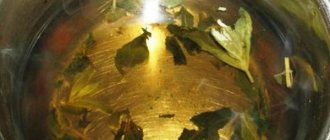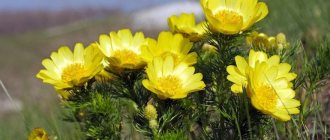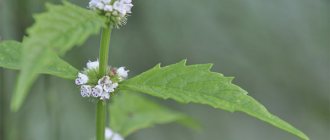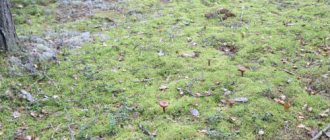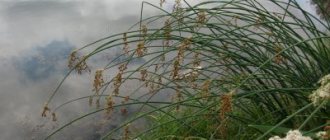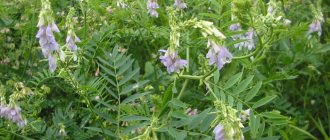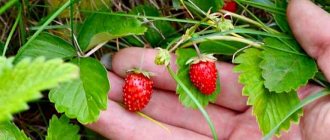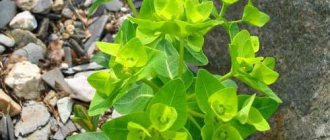Botanical description
If you look at the Morrison's gorychium in the photo, you will see that it is a plant with a tall, erect stem. Its height can reach 2 meters. The stem is empty inside.
On the outside, it has small dissected leaves 10-50 mm wide. These leaves are located on the upper part of the stem of Morrison's gorychnik. On its lower part (at the root) there are large leaves up to 100 mm long. They have a trifoliate shape.
A young plant has a tap root, but over time the rhizome of this representative of the flora takes the shape of a radish and is covered with tuberous bark of a brown-black hue. When cut, the gorichnik root has a yellow-green core that secretes a yellow resinous liquid.
The plant blooms with green-yellow small flowers, collected in complex umbrellas with a diameter of up to 150 mm. After flowering, fruits in the form of winged two-seeds are formed on the umbrellas. Its length does not exceed 1 cm.
Morrison's gorichnik - medicinal properties and contraindications
Morrison's gorichnik is a perennial plant with a diuretic, diaphoretic, disinfectant, wound-healing and antispasmodic effect. It is used to treat colds, gastrointestinal pathologies and bronchitis. This remedy cleanses the blood well and even prevents the development of tumors.
Botanical description
If you look at the Morrison's gorychium in the photo, you will see that it is a plant with a tall, erect stem. Its height can reach 2 meters. The stem is empty inside.
On the outside, it has small dissected leaves 10-50 mm wide. These leaves are located on the upper part of the stem of Morrison's gorychnik. On its lower part (at the root) there are large leaves up to 100 mm long. They have a trifoliate shape.
A young plant has a tap root, but over time the rhizome of this representative of the flora takes the shape of a radish and is covered with tuberous bark of a brown-black hue. When cut, the gorichnik root has a yellow-green core that secretes a yellow resinous liquid.
The plant blooms with green-yellow small flowers, collected in complex umbrellas with a diameter of up to 150 mm. After flowering, fruits in the form of winged two-seeds are formed on the umbrellas. Its length does not exceed 1 cm.
Classification
Morison's gorichnik belongs to the genus Gorichnik, which belongs to the Umbrella (Celery) family. Not only a medicinal plant belongs to this genus. It also includes other varieties of gorichnik.
The nasturtium species known as royal root is used in cooking. Its herb is used to make Swiss cheese, and its rhizome is used to make an alcoholic drink.
Useful properties of the plant
Due to its chemical composition, Morrison's grass has the following effects on the human body:
- Prevents the division of cancer cells and promotes the removal of toxins after chemotherapy;
- Dilates the blood vessels of the heart muscle;
- Strengthens the walls of capillaries;
- Helps in the fight against fungus and viruses;
- Strengthens the immune system;
- Relieves pain in stomach and lung cancer. Gorichnik also helps with migraines.
folk recipes
Gorichnik is used in folk medicine in the form of decoctions, infusions and tinctures. There are many recipes for preparing medicines from this plant.
Infusion for colds
To treat colds and bronchitis, an infusion of gorichnik is used. It’s better to do it right away in a thermos. In this case, the gorichnik will better retain its beneficial properties, and you will be able to drink the hot infusion throughout the day.
To prepare the product, take a dessert spoon of pre-crushed gorichnik per 2 cups of boiling water. The mixture is infused for an hour. You need to take the infusion 3-4 times a day, 100 g each. If you have bronchial asthma, inhalation will help you. But a concentrated decoction is better suited for them. In this form, the gorichnik works well to cleanse the bronchi of mucus.
Contraindications to the use of gorichnik
Gorichnik has no contraindications, except for individual intolerance to the components of the plant. But you must remember that the grass and roots of this representative of the flora contain a large amount of biologically active substances.
Their use is undesirable during pregnancy (especially in the first and last trimester). By taking gorichnik preparations, you risk causing premature birth or harming the baby. It is also not recommended to use this remedy in the acute phase of gastrointestinal diseases.
Procurement of raw materials
Gorichnik grass must be harvested during the flowering period. At this time, there are a lot of biologically active substances in its terrestrial part.
If you want to harvest gorichnik rhizome, do it in the fall or spring, when there are no leaves and flowers. By giving away nutrients to the ground part, gorichnik loses its beneficial properties and becomes less effective in treating diseases.
After digging up the root, dry it in a ventilated area. You cannot wash the rhizome, so just shake off the soil and lay it out to dry.
When the tuber dries a little, chop it into small pieces. Their dimensions should be no more than 4 cm. In this form, dry the gorichnik at room temperature or in a dryer, setting the temperature to 50 degrees.
If you have the opportunity, grind the rhizome into powder. This will make it easier to use when preparing medications.
Flowering calendar
Gorichnik blooms throughout July and August. At this time, its shoots, along with leaves and flowers, are collected and dried. If you need to prepare seeds, do so after they are fully ripe.
Application of roots and herbs
Morison's gorichnik is used to treat:
- bronchial asthma (you can take the drug orally and do inhalation);
- diseases of the gastrointestinal tract and liver;
- inflammatory processes in the gallbladder;
- bronchitis;
- inflammation of the oral cavity;
- insomnia.
With the help of gorichnik, toothache is relieved (by rinsing) and pain due to radiculitis, gout and rheumatism (with hot poultices). The juice of this plant is used to treat insect bites. To enhance the effect, it is better to take gorichnik juice internally, and not just make lotions from it.
In medicine
This plant significantly enhances the effect of streptomycin, tetracycline and chloramphenicol. It is prescribed by doctors to treat infectious diseases with antibiotics. By taking gorichnik preparations, the patient can reduce the dose of antibiotics and avoid side effects from their effects. But only a doctor should calculate the required dosage of medications.
Gorichnik plant
Gorichnik belongs to the Umbrella family and is a perennial herbaceous plant. The leaves of the bitterweed are petiolate, finely dissected.
This medicinal plant is characterized by the presence of a rather large striped root. The flowers are colored yellow and collected in complex umbels. Gorichnik officinalis blooms in summer (July-August).
The habitat is meadows and fields of the European part of Russia, Belarus and Ukraine.
Possessing a number of unique beneficial properties, gorichnik officinalis has found wide use in folk medicine. Harvesting roots can be done either in late autumn or early spring. To do this, the roots are cut into small pieces and dried in a place protected from light. The aerial part of the medicinal plant is harvested during the flowering period. The seeds are harvested at the time of their ripening.
The aboveground and underground parts of the plant contain large quantities of essential oils.
Coumarins (bergaptol, peucedin, peucenol, isomeratorin, peudacedanin), carbohydrates (sucrose) and pectin were found in the underground part of the gorychnik officinalis (roots).
The aerial part contains resins, gum, flavonoids (quercetin, rutin, isorhamnetin, kaempferol). The medicinal plant has a pronounced wound-healing, diaphoretic, antispastic and diuretic effect.
In folk medicine, a medicinal decoction of gorichnik is used for bronchial asthma - internally and in the form of inhalations.
Also, a healing decoction of gorichnik is used for various liver diseases, diseases of the gastrointestinal tract, inflammation of the gallbladder, and insomnia.
The plant has a mucolytic effect (used for bronchitis), antiseptic (used for diseases of the oral cavity), analgesic (gargling for toothache).
Tribulus creeping plant
Gorichnik infusion (roots): 1 part of the crushed roots of the medicinal plant is poured with 5 parts of 70% ethyl alcohol, the resulting infusion is left for 10–14 days in a dark place, protected from direct sunlight, after which it is filtered into a clean and dry container and taken 1 teaspoon (5 ml) 3 times a day before meals.
Infusion of gorichnik (leaves and flowers): 30 g of the aerial part of the medicinal plant is poured into 200 ml of boiling water, placed in a boiling water bath for 10–15 minutes, and then cooled for 45 minutes and filtered into a dry container. Take 1/3 cup orally warm infusion 3 times a day.
READ MORE: Vodka for Colds - medicinal properties, recipes and reviews
Gorichnik decoction (above-ground and underground parts): 20 g of crushed medicinal raw materials are poured into 200 ml of boiling water, the resulting decoction is kept for 30 minutes in a boiling water bath, then cooled for 10 minutes (without removing from the stove), filtered. Take a decoction of 1/3 cup 3-4 times a day.
Morrison's Gorichnik
Morrison's gorichnik is a perennial herbaceous plant with a powerful tap root. The stem is most often single, reaching a height of 120–150 cm. The basal leaves form a dense rosette.
The inflorescences are collected in numerous umbrellas, consisting of 20–40 rays. The flowers are small, yellow and green. The medicinal plant blooms from July to August, the fruits ripen in September.
The distribution area of Morrison's gorychnik is the steppe and forest-steppe regions of Western Siberia, Altai and Kazakhstan.
Very often the plant forms dense thickets. The roots of the plant contain in their chemical composition furocoumarin peucedanin (from 0.7 to 4%), coumarins, sucrose, leaves contain peucedanin, flowers - quercetin, isorhamnetin, isorhamnetin glycosides, kaempferol. The inflorescences contain isorhamnetin and quercetin.
Due to the content of furocoumarin peucedanin in the roots, Morrison's cinnamon is used to treat all types of malignant neoplasms and is effective for breast cancer.
Infusion and decoction of the medicinal plant is also used for epilepsy, headache and toothache, atherosclerosis, rheumatism, gout, and bronchial asthma.
Due to its pronounced expectorant effect, the healing infusion is used for chronic diseases of the bronchopulmonary system (chronic bronchitis).
Medicinal plants. Ginseng, Alder, Rue, Hawk.
Externally, an infusion of Morrison's gorichnik is used for chondrosis, arthritis, radiculitis and rheumatism (the infusion is rubbed into the site of pain). The decoction is used to rinse the mouth. The remedy is excellent for various inflammatory diseases (stomatitis, gingivitis, bad breath).
Morrison's gorichnik decoction: 1 teaspoon of crushed roots is poured into 300 ml of boiling water, placed in a boiling water bath for 5 minutes, then infused for 1 hour and filtered into a clean and dry container. Take 1/4 cup 3 times a day before meals.
Alcohol tincture of Morrison's gorychnik: 50 g of dry root, pour 500 ml of 45% ethyl alcohol, infuse in a dark place for 14–15 days. Take the finished product 3 times a day, 25–30 drops.
Individual intolerance (allergic reactions).
Folk recipes
Gorichnik is used in folk medicine in the form of decoctions, infusions and tinctures. There are many recipes for preparing medicines from this plant.
Root decoction
The rhizome of gorichnik is most often used, as it contains a large amount of useful substances. If you are making a decoction for internal use, take 1 part of crushed gorichnik to 10 parts of water.
The mixture cannot be simply cooked over an open fire. It must be cooked in a water bath (the pan with the future broth is placed in a container of boiling water). The mixture is boiled in a covered saucepan for an hour (you can use a glass jar with a lid). Then it is filtered and put in the refrigerator.
A decoction of gorichnik is taken 3 times a day, 3 dessert spoons. This should be done in between meals (not on an empty stomach and not immediately after meals). If you are treating diseases of the gastrointestinal tract, you need to take the decoction on an empty stomach.
Alcohol tincture
Alcohol-infused gorichnik is made for internal and external use. The tincture is taken orally for:
- oncological diseases of the gastrointestinal tract;
- pathologies of the genitourinary system;
- dropsy.
Tincture of gorichnik relieves toothache by applying a compress to the sore spot. This product is also used to disinfect purulent wounds.
To prepare gorichnik tincture, you need to take medical alcohol and dilute it with water 1:2. If you don't have alcohol, use quality vodka. You will need half a liter of vodka per glass of crushed plant. The mixture is placed in a dark place for 2 weeks and shaken daily.
The finished gorichnik tincture is filtered and stored in the refrigerator. You need to consume it 1 dessert spoon before meals 3 times a day. You need to take gorichnik according to this regimen for 30-60 days. After completing the course, a short break is taken, then the treatment continues.
When using gorichnik internally, do not forget that this is a medicine, not an alcoholic drink. Under no circumstances should you drink the tincture like regular vodka. Gorichnik contains a large number of biologically active components, so exceeding the dose can lead to serious complications.
Infusion for colds
To treat colds and bronchitis, an infusion of gorichnik is used. It’s better to do it right away in a thermos. In this case, the gorichnik will better retain its beneficial properties, and you will be able to drink the hot infusion throughout the day.
To prepare the product, take a dessert spoon of pre-crushed gorichnik per 2 cups of boiling water. The mixture is infused for an hour. You need to take the infusion 3-4 times a day, 100 g each. If you have bronchial asthma, inhalation will help you. But a concentrated decoction is better suited for them. In this form, the gorichnik works well to cleanse the bronchi of mucus.
Methods of preparation and use
Traditional medicine prepares mainly decoctions and infusions, as well as alcohol extracts, based on Morrison's medicinal gorychnik. With proper heat treatment, the plant retains maximum beneficial properties.
Tincture
Alcohol tincture of gorichnik is beneficial for dropsy, cancer, inflammation and pain. The drug is prepared according to the following algorithm:
- Grind the dried root of the plant in the volume of a glass.
- Pour the raw material with 500 ml of vodka.
- Place the solution in a closed container in a dark place for two weeks.
- Shake the container daily.
We recommend reading: Dandelion syrup: benefits and harms, use, how to take
After the expiration date, the drug must be strained through gauze to remove sediment. Drink 10 ml tincture three times a day on an empty stomach. In total, treatment is usually continued for up to two months, and then a break is taken for 2-3 weeks.
Advice! You can prepare a tincture using alcohol, after diluting it with water in a ratio of 1:2.
Gorichnik tincture can be used to disinfect purulent wounds
Infusion
A universal remedy is an infusion of flowers and leaves of Morrison's cinnamon. You can take it for colds and coughs, liver ailments and poor bile flow. The recipe for preparing the drug looks like this:
- About 30 g of dry leaves and flowers are poured into 200 ml of boiling water in a glass container.
- Place the solution in a water bath for 15 minutes.
- After the expiration date, remove from the stove and leave for 45 minutes under the lid.
- Strain from the sediment.
You need to drink gorichnik infusion 1/3 cup three times a day. It is recommended to warm the product before use.
Gorichnik infusion is suitable for gargling for coughs and sore throats
Decoction
For digestive diseases, it is recommended to use a decoction of Morrison's medicinal mustard. The drug is prepared according to the following recipe:
- Pour 200 ml of boiling water over about 20 g of dry crushed leaves and roots.
- Place the product in a water bath for half an hour.
- After the expiration date, remove from the stove and cool under the lid for ten minutes.
- Filtered.
The finished decoction is consumed in 80 ml up to four times a day.
Morrison's gorichnik decoction strengthens the immune system and helps with the first symptoms of a cold
Contraindications to the use of gorichnik
Gorichnik has no contraindications, except for individual intolerance to the components of the plant. But you must remember that the grass and roots of this representative of the flora contain a large amount of biologically active substances.
Their use is undesirable during pregnancy (especially in the first and last trimester). By taking gorichnik preparations, you risk causing premature birth or harming the baby. It is also not recommended to use this remedy in the acute phase of gastrointestinal diseases.
Gorichnik - description, medicinal properties, application
The roots are the raw material for the production of the drug "Peucedanina", used for the treatment of vitiligo, alopecia areata and as an antitumor agent.
In the experiment, the essential oil exhibited virucidal activity against the influenza virus and fungicidal activity against many fungal infections, as well as anti-inflammatory and analgesic activity against acute respiratory infections.
The root extract in the experiment has antibacterial and fungicidal properties.
Morrison's rib, otherwise known as Adam's rib, is a fairly powerful antitumor agent. In addition, it is also used in the treatment of gastrointestinal diseases, colds and bronchitis. Since ancient times, this plant has been used in folk medicine. To prepare medicines, not only the roots are used, but also the entire above-ground part of the gorichnik.
Gorichnik is an umbelliferous family and belongs to a perennial herbaceous plant. The leaves of the gorichnik are petiolate, finely dissected, the root is large and striped. The flowers are yellow and collected in complex umbels.
Medicinal gorychnik begins to bloom in mid-summer, most often in meadows, fields, in Ukraine, Russia, and Belarus. The plant is popularly called siren root, royal root, magister root.
The medicinal gorichnik is also translated from Latin as bear root, tail grass, medicinal gorichnik, tail, zheltolen, wild crop.
Description of the gorichnik
Folk healers use Morrison's gorychnik most of all; it is a perennial herbaceous plant species, has a powerful taproot, a single stem that can reach a height of about 150 centimeters.
The leaves at the roots of Morrison's gorychnik are collected in a dense rosette, the inflorescence is formed into umbrellas, which include 40 rays. Gorichnik flowers are small in size and can be yellow or green.
It begins to bloom in mid-summer, the fruits are ready in early autumn.
Morrison's gorychium grows in the steppe, forest-steppe, Western Siberia, Kazakhstan, Altai. Very dense thickets can form. The root contains a large number of chemicals such as furocoumarin and sucrose. The leaves are rich in peucedanin, the flowers are rich in glycosides, isorhamnetin, quercetin. Inflorescence on isorhamnetin.
Morrison's rib, otherwise called “Adam's rib,” is a fairly powerful antitumor agent. In addition, it is also used in the treatment of gastrointestinal diseases, colds and bronchitis. Since ancient times, this plant has been used in folk medicine. To prepare medicines, not only the roots are used, but also the entire above-ground part of the gorichnik.
READ MORE: Lemon glycerin honey for cough reviews
Morrison's gorychnik (photo can be seen in this article) belongs to the Umbrella family and is a perennial herbaceous plant. It has the following characteristic features:
- The umbrella-shaped inflorescences are often bright yellow.
- Grows mainly in forest and forest-steppe zones.
- The gorichnik root is quite large, with characteristic stripes.
- The leaves are small and dissected.
The height of the stem sometimes reaches 110 cm. The plant loves moisture and is quite sensitive to drought.
Almost all parts of the plant are used to prepare traditional medicine recipes, but most attention is paid to the root. The medicinal properties of Morrison's mustard have been practically studied.
It is quite large, striped, and contains a large amount of useful substances. Components such as isomeratorin, bergaptol, peudacedanin, and so on were found in its composition. In addition, the roots contain a lot of pectin and carbohydrates.
Leaves, stems and inflorescences contain rutin, kaempferol, gum and resinous substances.
It is used for many diseases. For example, a weak decoction of the root is used for epilepsy, gastrointestinal diseases, and vitiligo.
A strong water decoction is most often used to treat diseased joints, and an alcohol tincture for toothache, inflammation of the genitourinary system and oncology.
Thanks to its anti-inflammatory properties, the root perfectly relieves bronchitis and pleurisy, and helps in the complex treatment of pneumonia.
Gorichnik herb is included in the list of antitumor plants due to the presence of very rare components in its composition. An active effect of preparations from parts of this herb on the division of cancer cells was observed.
It becomes especially noticeable after chemotherapy, when the patient needs help to remove toxic substances and restore the body after stress.
It strengthens the immune system, which also promotes recovery.
For oncology of the lungs and stomach, Morison's gorichnik improves blood circulation, acts as an analgesic and maintains general tone.
Root decoction
It can be prepared either more concentrated or less concentrated. For oral use, as a rule, a composition is prepared in which the ratio of dry raw materials to liquid will be 1:10. The most optimal method of preparation is a decoction in a water bath.
To do this, select two pans, one of which will be smaller in size, and the other about half as large. The future broth will be in a small container, and water is poured into a larger one. One pan is placed on the fire, and the second is placed inside the first.
The water begins to boil and heat the liquid in a small container.
Use the resulting product three dessert spoons no more than three times a day. The reception time should be between breakfast, lunch and dinner. If the remedy is used to treat diseases of the gastrointestinal tract, then the best option would be to use the decoction before meals and only on an empty stomach.
Alcohol tincture
To prepare it you will need either good quality vodka or medical alcohol diluted in a 1:2 ratio.
A glass of pre-prepared raw materials is poured with a half-liter bottle of vodka and sent to infuse in a dark place at room temperature. Every day the tincture is taken out and shaken. In two weeks the composition will be ready.
It is filtered through double gauze and stored in the refrigerator. Use the product in very measured doses, no more than one dessert spoon before breakfast, lunch and dinner.
An overdose can lead to undesirable consequences. The tincture is used mainly to combat oncology of the gastrointestinal tract.
In addition, it has proven itself well in the treatment of diseases of the genitourinary system and dropsy.
A cotton swab dipped in tincture is used to treat toothache. To do this, cover the diseased tooth with compresses made of gauze or cotton wool and hold it until the pain subsides.
The course of treatment is usually 1-2 months. After a short period it is continued.
It is used both for diseases of the upper respiratory tract caused by colds and for acute bronchitis. To prepare the product, it is advisable to take a thermos. For one dessert spoon of crushed raw materials you will need no more than 2 glasses of boiling water.
The raw materials are poured into a thermos, which is tightly closed with a lid and left to infuse for 1 hour. The drug is taken according to the following scheme: 100 grams 3 to 4 times a day. Thanks to the thermos, the broth does not cool down throughout the day.
For bronchial asthma, inhalations are also done using a concentrated decoction of Morrison's gorichnik. The lungs are cleared of phlegm and mucus quite quickly.
Procurement of raw materials
The roots of this plant are harvested either in early spring or late autumn. One of the main conditions is the absence of leaves and inflorescences.
https://www.youtube.com/watch?v=WZ738G0Iz0s
It is during this period that the root has full strength, which it did not have time to give to the ground part. The dug up root is shaken off the soil and laid out to dry. Raw materials cannot be washed or processed in any way.
As it dries, you can periodically shake it off the ground.
The raw root is cut into several parts in advance to make it convenient to use in the future. It is best to grind the root into a powder. Pharmaceutical drugs are sold in this form. If this is problematic to do at home, you can leave small cuttings no larger than 3-4 cm in size.
Morison's gorichnik has virtually no contraindications except for pregnancy in the first and last trimester. During this period, it is strictly not recommended to use any biologically active herbs, so as not to harm the baby or cause premature birth.
READ MORE: Melissa for men - benefits and harms - medicinal properties
In case of exacerbation of any diseases of the gastrointestinal tract, you should also refrain from taking drugs with Morrison's gorichnik.
In their reviews, patients very often discuss the medicinal properties and contraindications of Morrison's gorychnik and recommend using this herb to treat oncology, pulmonary diseases and stomach ulcers.
Patients with gastrointestinal diseases note a fairly rapid positive effect of this remedy. In their opinion, the first improvements occur already on the third day, and by the end of the course of treatment the symptoms of the disease disappear.
Those who have already tried Morison's mustard decoction once for bronchitis or acute respiratory infections highly recommend it. It has a pronounced antipyretic effect.
Children, according to parents, recover quite quickly and after a while become cheerful and cheerful.
Procurement of raw materials
Gorichnik grass must be harvested during the flowering period. At this time, there are a lot of biologically active substances in its terrestrial part.
If you want to harvest gorichnik rhizome, do it in the fall or spring, when there are no leaves and flowers. By giving away nutrients to the ground part, gorichnik loses its beneficial properties and becomes less effective in treating diseases.
After digging up the root, dry it in a ventilated area. You cannot wash the rhizome, so just shake off the soil and lay it out to dry.
When the tuber dries a little, chop it into small pieces. Their dimensions should be no more than 4 cm. In this form, dry the gorichnik at room temperature or in a dryer, setting the temperature to 50 degrees.
If you have the opportunity, grind the rhizome into powder. This will make it easier to use when preparing medications.
Description and characteristics
Morrison's gorychnik (photo can be seen in this article) belongs to the Umbrella family and is a perennial herbaceous plant. It has the following characteristic features:
- The umbrella-shaped inflorescences are often bright yellow.
- Grows mainly in forest and forest-steppe zones.
- The gorichnik root is quite large, with characteristic stripes.
- The leaves are small and dissected.
The height of the stem sometimes reaches 110 cm. The plant loves moisture and is quite sensitive to drought.
